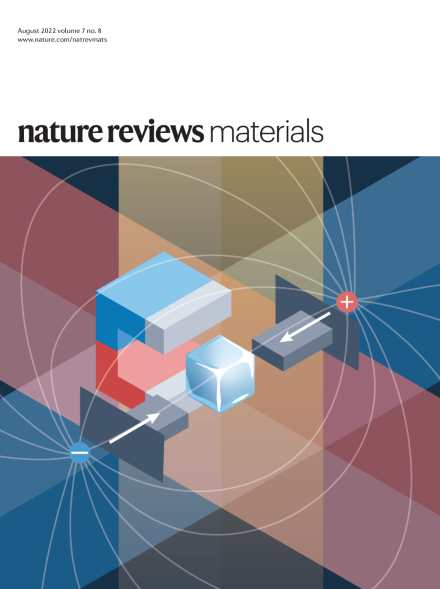
|
 |
Multicaloric cooling promises environmentally friendly and high-efficiency refrigeration. This cover artistically illustrates magnetic and electric fields and pressure acting together to cool a multicaloric material. |
|
As we see the effect of climate change before our eyes, calls to minimize greenhouse gas emissions and demands for higher energy efficiency continue to drive research into green cooling and refrigeration technologies, which do away with ubiquitous vapor compression where refrigerants are hydroflourocarbons (HFCs) with high global warming potentials. Among the alternative cooling technologies are caloric cooling based on field-induced solid-state phase transitions. The field of caloric cooling has undergone a series of changes over the past 50 years, bolstered by the advent of new materials and devices, and these developments have led to the emergence of the concept of multicaloric cooling in the past decade.
Ichiro Takeuchi, a professor in the University of Maryland (UMD) Department of Materials Science and Engineering (MSE), together with his colleagues Huilong Hou (Beihang Univ.) and Suxin Qian (Xian Jiaotong Univ.) have published a major perspective article in this burgeoning field of multicaloric cooling as a new direction in environmentally friendly refrigeration technology. The article discusses new materials and their physics involving coexisting ferroic order parameters which can lead to multicaloric cooling processes. The authors examine key factors that govern the overall system efficiency of potential multicaloric devices. The study was published in the August issue of Nature Reviews Materials as a cover article (https://www.nature.com/articles/s41578-022-00428-x).
Caloric materials that are responsive to magnetic, electric or stress fields are called magnetocaloric, electrocaloric, or mechanocaloric, respectively. Cooling technologies based on caloric materials derive heat-pumping capabilities from the manipulation of internal order parameters. Caloric materials exhibit high energy-conversion efficiencies and do not emit greenhouse gases. Multicaloric materials in turn possess one or more types of ferroic order that can give rise to multiple field-induced phase transitions that can enhance various aspects of caloric effects.
“Just as multiferroic materials with co-existing ferroic order parameters have unveiled a plethora of novel physical phenomena and applications in the last decade, multicaloric cooling materials stand to open up new avenues for extracting heat and spearhead hitherto unknown technological applications,” says Takeuchi.
Takeuchi has been working closely with Reinhard Radermacher and Yunho Hwang in Mechanical Engineering at UMD to develop elastocaloric materials and devices for more than a decade. (See related news stories: https://mse.umd.edu/news/story/the-future-of-cool-additive-manufacturing-and-niti-metal-bolster-cooling-technology; https://mse.umd.edu/news/story/umd-research-team-develops-compact-solid-state-cooling-technology; https://mse.umd.edu/news/story/28m-doe-grant-funds-continued-development-of-cooling-technology). Elastocaloric cooling is one type of mechanocaloric cooling, and it won a UMD Outstanding Invention of the Year Award in 2010 (https://mse.umd.edu/news/story/novel-smart-metal-physical-sciences-invention-of-the-year). In 2014, DOE ranked elastocaloric cooling, also known as thermoelastic cooling, as the most promising alternative cooling technology (https://www.energy.gov/eere/buildings/downloads/non-vapor-compression-hvac-technologies-report). Because of the versatile nature of this effect, elastocaloric cooling can serve as an important component in various modes of multicaloric cooling, as highlighted in the article.
The perspective article also touches on engineering and manufacturing aspects of caloric cooling technologies. “From additive manufacturing to intelligent design of heat exchangers, advanced materials processing techniques are expected to be the lynchpin, even in the system assembly and integration stage of development of cooling systems,” said Hou, the first author of the work. Takeuchi and the team have made significant progress in building prototypes of elastocaloric cooling systems. “We hope to have demonstration units ready to go within a year,” says Takeuchi.
For additional information:
Hou, H., Qian, S. & Takeuchi, I. Materials, physics and systems for multicaloric cooling. Nature Reviews Materials 7, 633–652 (2022). DOI: 10.1038/s41578-022-00428-x
Related Articles:
Electrified Plastic Recycling Toward A Sustainable Future
Former ISR postdocs win advanced materials awards
August 22, 2022
|